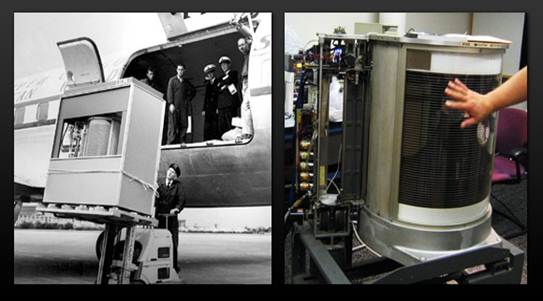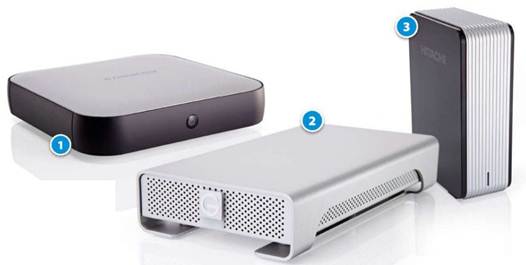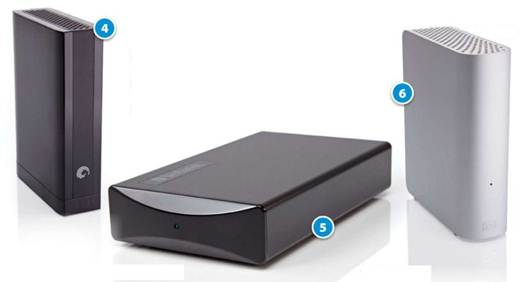We take a look at high-capacity external
data storage options from four leading manufacturers
Hard drives have come a long way since IBM
introduced the RAMAC 305 system back in 1956. This, the first hard drive, was
the size of two fridges, cost $50.000 and stored just 5MB of data. In the five
decades since, the world has gone digital and hard drives have gone mainstream.
Demand for storage capacity has increased,
with digital media, such as photos, music and video, demanding space alongside
traditional data, such as apps and files. And driven by this demand, hard drive
manufacturers strive for ever-increasing capacities without the sky-high cost.

The
first hard disk drive, IBM Model 350.
In this group test, we look at high capacity
desktop hard drives of at least 2TB in size. Based on the larger 35-inch hard
drive, desktop drives are bulkier than the smaller 2.5-inch portable drives and
require an external power source, but they give a better price per GB. If you
want an external drive and you don’t need to carry it around, a desktop drive
is the way to go.
External drives, such as the desktop drives
covered here, can be used as a boot drive. This is useful if the internal drive
in your iMac or Mac mini fails, but you don’t want the expense of taking it in
for repair. An Intel Mac can boot from a USB drive, but if you have a PowerPC
Mac, it can only boot from FireWire. Although Macs can read drives formatted
for PCs, the boot drive must be Mac-formatted. And, of course, external drives
can be used with Time Machine, automatically backing up your Mac’s files and
apps.
These days, many hard drives offer USB 3.0
transfer speeds. A USB 3.0 connection is more than ten times faster than the
USB 2.0 protocol, but devices that use the high-speed USB format are
backwards-compatible; they can be used in USB 2.0 ports, but at the slower, USB
2.0 speeds. Until recently, Macs only used USB 20, but if you have the latest
MacBook Pro or MacBook Air, you can get the most out of a USB 3,0 hard drive. Even
with an older Mac it will work under USB 2.0.
Test one
Design & build
We test for build quality and
aesthetics
The WD and G-Drive are both excellently
designed to match your Mac, with their all-metal casings and sleek, contoured
lines. The WD My Book Studio retains the company’s famous book-like build. The
G-Drive clearly takes its inspiration from the Mac Pro, but would look good
next to any Mac. Unfortunately, it’s seriously marred by an over bright LED
that’s very distracting if it’s in your peripheral vision. Both are a little
heavy, but that’s not really a problem with desktop hard drives.

The
WD and G-Drive are both excellently designed to match your Mac, with their
all-metal casings and sleek, contoured lines.
Freecom’s Hard Drive Sq is also attractive,
its unusual square design standing out from a largely rectangular crowd. It’s
well built and near silent too. The Seagate and Verbatim offerings are also
well built, but they’re more Spartan and austere than the others. They’re far
from ugly, but aren’t designed to be noticed. The Touro’s all-plastic body is
clearly Apple-influenced, but it looks like an iPhone that ate all the pies. It
picks up fingerprints too.
Test two
Performance
Measuring speed and connectivity
For the Fastest Read/Write Speeds’ test,
the Freecom, Hitachi and Seagate drives use US8 3.0, a connectivity protocol
only available on 2012 notebook Macs. If you don’t have a new MacBook, ignore
these results. You can still use the drives, but at USB 2.0 speeds.
The G-Tech and Western Digital drives use
FireWire 800, with the latter benefiting from a bundled Turbo Driver. Both
include a 400-to- 800 cable so you can use them with the older FireWire ports.
Again, ignore these results if you own a Retina MacBook Pro cx a MacBook Air,
neither of which have FireWire. The USB 2.0 scores are good for all Macs, as
current Macs have US8 2.0. The Verbatim is USB 2.0 only.
Full marks for the Touro and the WD, both
of which put in great across the board speeds. The Seagate was a little faster
(or USB 3.0 sequential writes, but its read and USB 2.0 speeds were slower. The
Freecom was slow, and the Verbatim loses marks for being LJSB 2.0 only.
Test three
Features & software
Over and above the standard hard
drive
The Seagate’s out in front here, with its
interchangeable base giving USB 3.0 connectivity out of the box, but it can be
swapped for a FireWire or even Thunderbolt adapter. Four LEDs on the front give
an indication of how full it is, and its software bundle includes an NTFS
driver so your Mac can write to Seagate NTFS-formatted drives.

My
Book Studio has an impressive Turbo Driver that increases speeds for both
FireWire and USB connections.
My Book Studio has an impressive Turbo
Driver that increases speeds for both FireWire and USB connections. There’s
also a formatting tool and WD Smartware, for securing and backing up files. The
Touro and the G-Drive both feature fast 7200rpm hard drives. G-Drive offers no
software but its desktop icon is effective. Touro has a backup app and 3GB of
cloud storage. It’s NTFS4ormatted out of the box, so unless you have an NTFS
driver installed, you’ll have to reformat before using it. The Freecom bundles
a few apps, but none are that exciting, and the Verbatim has a sole app, which
is Windows-only.
Test four
Value for money
It’s all about the price per-GB
Full marks Backup Plus Desktop drive has
the lowest pike per GB of the drives we tested, and it also has an impressive
feature set and software bundle. The Western Digital and Hitachi models also impressed.
Touro Desk Pro was the second- cheapest on a per GB basis, and although there’s
not a lot to make it stand out from the crowd, it’s pretty quick and, once
you’ve reformatted, it’s ideal as a Time Machine drive.
The Freecom and G-Tech drives are most
expensive, but neither are horrendously priced given the quality they offer.
Both look stylish (though the G-Drive is less attractive when you’ve taped over
the searing LED), and both ace well made too. The Verbatim External Hard Drive
had an average cost per GB, but it was the lowest-priced drive included in
these tests. If you’re happy with a USB 2.0 2GB unit and have no need of
fripperies like bundled software, you could go for this one and save yourself a
few quid.